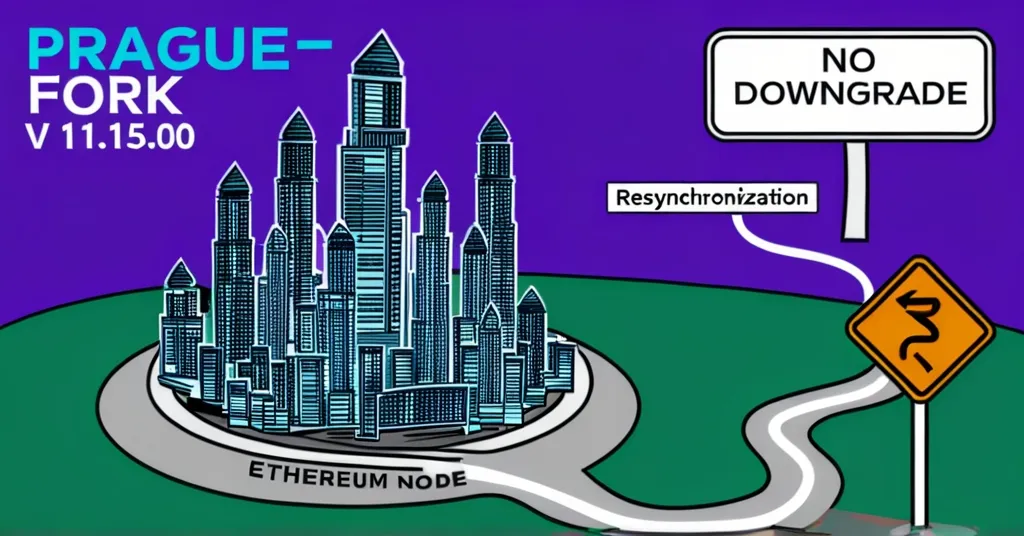Ethereum’s Geth v1.15.0 Launches, Paving Way for Prague Fork

Ethereum’s Geth v1.15.0: A Step Closer to the Prague Fork
Ethereum’s node software Geth has released version v1.15.0, ushering in the v1.15.x release cycle. This pivotal update is a crucial step towards the upcoming Prague Fork, poised to enhance Ethereum’s capabilities with new features and improvements. However, this release introduces significant changes to the node’s database, which could pose challenges for those contemplating a downgrade.
- Geth v1.15.0 initiates v1.15.x cycle
- Preparation for Prague Fork
- Database changes impact
- Full resynchronization required for downgrades
With Geth v1.15.0, Ethereum takes a bold step towards the future, marking the beginning of the v1.15.x series and setting the stage for the Prague Fork. This fork isn’t just another routine update; it’s a comprehensive overhaul designed to elevate the network’s performance. Yet, the release isn’t without its complexities. The database modifications mean that while we’re paving the way for future enhancements, reverting to earlier versions like v1.14.x is out of the question without a complete blockchain resynchronization. Think of it as re-downloading the entire history of Ethereum transactions—a tedious and resource-intensive task.
Ethereum’s path since adopting Proof of Stake (PoS) with the Merge has been a thrilling ride, with the Prague Fork representing the next big leap. It’s a testament to Ethereum’s commitment to continual improvement in scalability, security, and functionality. The recent urgent patch to Geth v1.14.13, which addressed CVE-2025-24883—a vulnerability that could have led to denial-of-service attacks—reminds us of the critical importance of staying current with these updates.
But what about the nitty-gritty? Geth v1.15.0 doesn’t just focus on the big picture; it also brings under-the-hood enhancements like improved ways the software communicates with the network (RPC methods), support for new Ledger firmware, and faster block import times. These might not grab the headlines, but they’re essential for the network’s smooth operation.
Let’s dive into the Prague Fork itself. It’s not merely an event but part of a larger set of upgrades, including the Electra upgrade, affecting both the execution and consensus layers of Ethereum. We’re talking about raising the validator effective balance limits, introducing new precompiled contracts for zero-knowledge proofs (zkSNARKs), and adjusting the gas costs for transaction data (calldata). These changes aim to streamline Ethereum’s operations, making it more efficient and user-friendly.
So, what’s the deal for you, the node operator? It’s time to buckle up. The database changes mean adapting to new methods of data storage and access. If you’re caught off guard and need to downgrade, prepare for a full blockchain resynchronization—a process about as fun as watching paint dry, but much more time-consuming and resource-heavy.
And let’s not overlook the collaborative spirit within the Ethereum community. The swift action taken to address CVE-2025-24883, coordinated across the board including with Layer 2 solutions, showcases a united front against potential threats. It’s a reminder that in the world of crypto, staying vigilant and updated isn’t just recommended; it’s essential.
As we move closer to the Prague Fork, Ethereum’s future looks promising. Yet, with great updates come great responsibilities. Node operators need to stay informed, keep their systems up to date, and perhaps maintain backup nodes to navigate these changes smoothly.
In the grand scheme, Ethereum’s journey is a testament to the power of decentralized technology. While we champion the advancements and the push towards a more decentralized future, we can’t ignore the challenges along the way. The ride is far from over, and as we progress, Ethereum’s commitment to improvement, security, and collaboration will be key to unlocking its full potential.
Key Takeaways and Questions
- What is the significance of Geth v1.15.0?
Geth v1.15.0 marks the start of the v1.15.x release cycle and is a crucial step towards the Prague Fork, setting the stage for significant enhancements to the Ethereum network.
- What are the implications of the database changes in Geth v1.15.0?
The database changes mean that node operators must adapt to new data management methods. Downgrading to earlier versions requires a full blockchain resynchronization, which is a major undertaking.
- How does the Prague Fork relate to this Geth update?
The Prague Fork is an upcoming network upgrade, and Geth v1.15.0 prepares the ground by introducing changes that align with the fork’s goals and requirements.
- What should Ethereum node operators be aware of with the new Geth version?
Node operators should be mindful of the database changes, the inability to easily downgrade, and the overall preparation for the Prague Fork with this new release.



